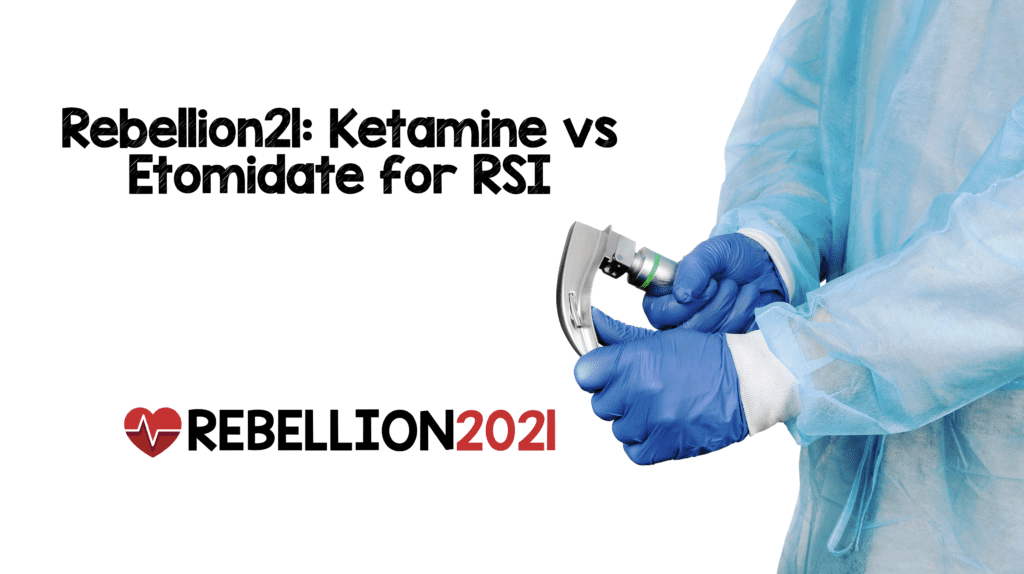
 Ketamine has been the recent go to for the hemodynamically compromised intubation. In this 18-minute presentation from Rebellion in EM 2021, Rob J. Bryant, MD reviews several studies of Ketamine vs Etomidate to clarify the current rationale for or against Ketamine for RSI.
Ketamine has been the recent go to for the hemodynamically compromised intubation. In this 18-minute presentation from Rebellion in EM 2021, Rob J. Bryant, MD reviews several studies of Ketamine vs Etomidate to clarify the current rationale for or against Ketamine for RSI.

Rob J. Bryant, MD
Emergency Medicine Faculty
Utah Emergency Physicians
Twitter: @RobJBryant13
Objectives
- Review current evidence in the use of Etomidate or Ketamine in patients with hemodynamic compromise requiring intubation
- Be able to defend your choice of Etomidate or Ketamine in patients requiring RSI
Outline
- Review RSI approaches using standard, and reduced dose Ketamine and Etomidate
- Review NEAR registry data on recent ED use of these agents
- Discuss limitations of observational studies
Ketamine vs Etomidate for RSI
- Mohr et al. Acad Emerg Med 2020. PMID: 32602974
- NEAR Cohort Registry Study
- Ketamine vs Etomidate in sepsis
- ≈500 patients: ≈250 etomidate vs ≈140 ketamine
- Primary Outcome: SBP <100mmHg within 15min of intubation
- Ketamine = 74% vs Etomidate 50%
- Vasopressor use within 15min of intubation
- Ketamine = 30% vs Etomidate = 23%
- Registry studies at best can show us trends and should be used as hypothesis generating trials and nothing more
- Without controlling for why a particular agent was used it is impossible to say if one agent was used in a sicker cohort compared to the other (Why was ketamine used instead of etomidate or vice versa?)
- Study doesn’t answer the question of reduced dose induction agents
- Critical Care 2015. PMID: 25879683
- Physiologically unstable trauma patients
- Etomidate 0.15mg/kg + 1.5mg/kg succinylcholine + 1mg/kg rocuronium vs Fentanyl 1mcg/kg + 1mg/kg ketamine + 1mg/kg rocuronium
- No difference in post intubation hypotension
- April et al. Acad Emerg Med 2020. PMID: 32592205
- NEAR Cohort Registry Study
- Ketamine <1mg/kg vs >1mg/kg and Etomidate <0.3mg/kg vs >0.3mg/kg
- ≈6800 patients: Etomidate ≈6,000pts and Ketamine ≈700pts
- Primary Outcome: Peri-intubation hypotension in all intubations (SBP <100mmHg within 15min of intubation)
- Ketamine = 18.3% and Etomidate = 12.4%
- SBP <100mmHg within 15min of intubation in trauma patients
- No difference between ketamine and etomidate
- SBP <100mmHg within 15 min of intubation in dose reduced vs standard dose strategies
- No difference
- Groups were unbalanced:
- More pts with sepsis in ketamine group
- Ketamine 19.9% and Etomidate 10.9%
- More pts with difficult airway characteristics in ketamine group
- Ketamine 69.2% and Etomidate 60.4%
- More pts with sepsis in ketamine group
- Jabre et al. Lancet 2009. PMID: 19573904
- Blinded Randomized Controlled Trial in France
- 655 critically ill patients
- Etomidate 0.3mg/kg vs 2mg/kg Ketamine
- Pre and Post Intubation Blood Pressure
- Etomidate: 5mmHg (-11 to 30)
- Ketamine: 10mmHg (-10 to 33)
- No statistical difference between groups
Bottom Line:
- Both NEAR trials were registry studies which do not allow for direct comparison of ketamine vs etomidate without randomization. Without randomization, the granular details of why a particular agent or dose of agent was chosen will lead to confounding factors that will give false conclusions
- Highest level evidence (Jabre et al) shows no difference in post-intubation hypotension rate (Ketamine = Etomidate)
- In “Big Sick” patients (Hemodynamically unstable), consider using reduced dose induction agents and a delayed sequence strategy to ensure patient is appropriately sedated before giving paralytics
Post Peer Reviewed By: Salim R. Rezaie, MD (Twitter: @srrezaie)
The post Rebellion21: Ketamine vs Etomidate for RSI via Rob J. Bryant, MD appeared first on REBEL EM - Emergency Medicine Blog.
